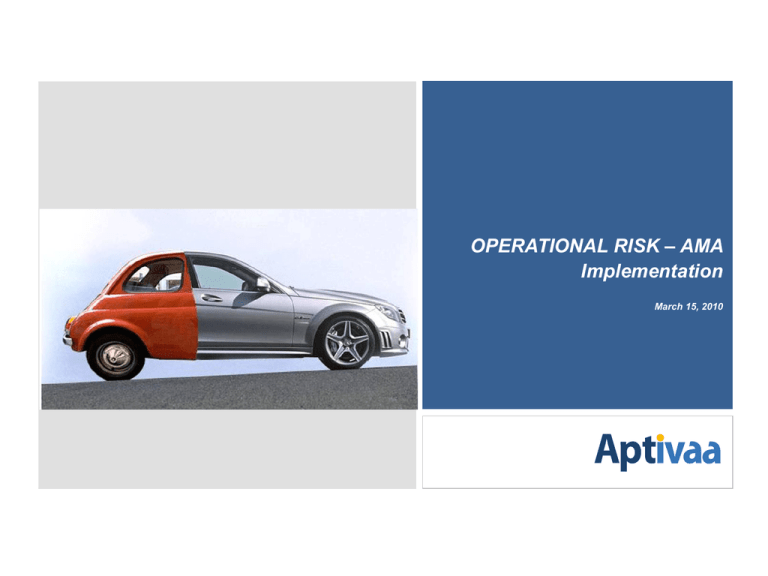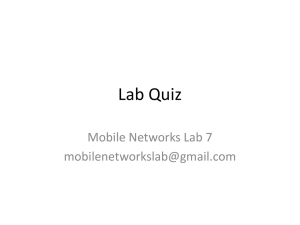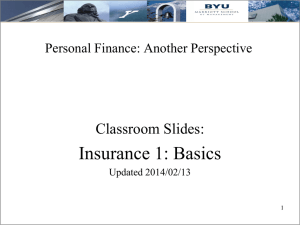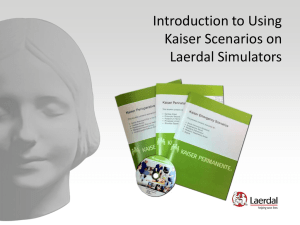OPERATIONAL RISK – AMA Implementation
advertisement

OPERATIONAL RISK – AMA Implementation March 15, 2010 Table of Contents Basel II Op Risk Introduction 3 Requirements for Approaches of Operational risk 4 Steps in implementing AMA 5 Rational e for moving to AMA 6 AMA Capital Calculation Framework 9 Steps for scenario approach 10 Steps for LDA 11 Comparison of both the Approaches 12 Challenges faced in Implementing LDA 13 Step by Step Methodology for Implementing Scenario Approach 17 Challenges faced in Implementing Scenario Approach 24 2 Requirements for Approaches of Operational Risk The Qualitative requirements are must to follow irrespective of any of the approach being followed by the bank as shown in the following slides. Qualitative / Quantitative Requirements M a n a g e m e n t M e a s u r e m e n t Self Assessment (Qualitative) Key Risk Indicators (Qualitative) Loss Data Management (Qualitative) Using Gross Income (Quantitative) Basic Indicator Approach Standardized Approach (BIA) (SA/ASA) Advanced Measurement Approach (AMA) √ √ √ √ √ √ √ √ √ √ √ Using Loss History (Quantitative) Using External Scenarios (Quantitative) √ √ Incremental Effort for AMA: To collect internal losses and maintain history of relevant losses for use in LDA To keep generating scenarios based on both events happening in your bank and also happening globally Use Business Environment & Internal Control Factor (BEICF ) o make the external scenarios relevant to be used by the experts Use of the appropriate method to incorporate the results of RCSA, KRI and LDM in the QAF Policy Sound Practices & Basel Requirements – Simplified steps in implementing AMA Operational Risk Management Policy Outsourcing Policy Loss Data Management Policy New Activity and Product Policy Disaster Recovery Policy Business Continuity Policy RCSA Policy Monitoring, Mitigation & Reporting Policy Training & Communication Strategy Management Data Process Key Risk Indicator Measurement Risk & Control Self Assessment Identify Key Risk Identify Risk Events Assess Inherent Risk Identify Key Risk Indicator Define & classify the Risk Events and causes Assess Control Effectiveness Establish Thresholds for KRI Identify & Define controls Assess the Residual Risk Establish Escalating, Monitoring & Reporting Process Validation of Risk Profile Template Document Control Gaps & Corrective Action Plan Risk & Control Database KRI Library Loss Data Management Loss Data Collection and Management Framework AMA Use Loss data using LDA to compute Capital requirement Use internal and external scenarios to compute capital requirement Design Risk Loss Database for AMA Capital Calculation To be discussed in this presentation Building a Business Case for AMA Bank may need to provide more or lesss capital for operational compared to Basic Indicator and Standardized Approaches depending on its risk profile Banks penalized most are the growing banks in emerging economies since their gross incomes keep rising significantly each year In adequacy of loss data However, banks use external scenarios to populate the losses and with proper scaling (BEICF) calculate Op Risk Capital using AMA This has also helped the banks save a greater amount of Op Risk Capital The aspiration for most of the growing banks is to move to Advanced Measurement Approach as soon as possible ??? Rationale For Moving to AMA contd… The graph shows comparison of the growth in Op risk Capital and the growth in operational losses year on year for the Indian banking industry. Gross Income of the industry is growing considerably with respect to the operational losses. Gross Income: includes Net Interest Income and other Fee based incomes Provision: includes provisions for contingency, other provisions and write-offs and excludes provisions for doubtful loans and NPA Provisions are considered to be a proxy for actual operational loss data as the actual data was never captured Op risk Capital is taken to be 15% of Gross income GI vs Provisions (Industry) Rs in Crores 70,000 60,000 50,000 40,000 30,000 20,000 10,000 0 GI Provisions 1997 1998 1999 2000 2001 2002 2003 2004 2005 2006 Years o Source of data : Capitaline o Industry figures include the top 10 banks in India o Growth is compared with 1997 figures as base. This clearly shows the advantages available to the banks to move towards AMA AMA Capital Calculation Framework – Different methods explained 99.99% percentile Adjusted Capital Scorecard / KRI Sample Data Regulatory Add on Aggregated Loss Distribution 99.99% percentile Integration Business Environment & Internal Control Factor Scenario analysis Template “Soft” Distribution 99.99% percentile Internal Loss Data Frequency and Severity distribution are created External Loss Data Monte Carlo Simulation “Hard” Distribution SBA LDA 7 Steps for LDA Approach Collect Loss Data from the Bank’s System and also adjust the Loss amount for “Non Insurance Recovery”. The distribution for the number of loss events occurring per year (i.e Frequency distribution) is assumed to be Poisson With respect to the loss amount per loss event (i.e severity distribution) , two types of simulation methods are often used: Parametric method, which uses simulations of numerical data assuming a specific statistical distribution; and Non-parametric method, which uses simulations of actual data without assuming a specific distribution. Frequency Distribution Estimation Severity Distribution Estimation Aggregate Loss Distribution using Monte Carlo Simulation VAR Calculation 8 Challenges for Loss Distribution Approach Challenges for LDA Setting up a consistent loss data collection process Creating blame free environment – encouragement to report losses Threshold determination Lack of adequate internal loss history The sanctity of the available data as it is not in sync with the actual booked losses Differentiating between event (loss incident ) and a non event ( near miss) Difference of opinion in defining loss events and near misses Difference of opinion in treating the recovery Relevancy of Internal Loss Data Some of the historical loss data captured in previous years may not be found relevant in future on account of any of the following reasons:- the concerned business may not be undertaken any more. the conditions, in which the loss event occurred, may not be relevant in future due to drastic change in control environments, e.g., change from manual to computerized operations shall make certain risk factors irrelevant. Since the risk profile of a bank changes over time, very old losses will be less representative. For estimation of frequency, internal losses that occurred in the last five years should be used and the losses of older years should be weighted accordingly 10 Change of Culture and Threshold Determination Change of culture where people are encouraged to report losses and near misses rather than hide it All business units should capture losses in a consistent framework rather than their individual way Carrot / Stick approach Determining threshold for capture of losses Once a threshold is decided, mostly losses are not reported a the estimated loss amount is just below the threshold amount Not deciding the threshold and capturing all losses is also herculean as many insignificant events populate the loss database which are irrelevant and already factored in the cost of doing business Different accounting treatment for both loss and recovery and hence the reconciliation problems 11 Steps for Scenario Based Approach Collect Loss Data from the Bank’s existing System. Also adjust the Loss amount for “Non Insurance Recovery”. If the no of data points is not sufficient ( particularly in case of Low Frequency High Impact losses) then supplement the internal loss data with external loss data provided by the vendors. Scale the external data based on CPI, Revenue, Asset and Income to Make the past reflect today Make external data look like internal Conduct Scenarios Workshop Generating Scenarios Translating Scenarios into Capital Stress Testing 12 Issues & Challenges for Scenario Approach Challenges for Scenario Based approach Finalizing the list of scenarios for each of the Basel event types is the biggest challenge to start with: Business Experts’ opinions expressed through scenario analysis information (to be collected during the pilot) Existing Internal Loss Events External Loss Events from the available databases Rational to prove that the external scenarios are relevant for the bank Use of the appropriate scaling technique or BEICF to make the external loss be relevant for the local / internal environment External size drivers are used to decide the severity buckets of the Scenario Analysis template The External Size Driver may be one of the following to scale the external event: Asset Size Gross Income/ revenue Operating Profit Currency of the Country along with the Sovereign rating CPI Index Number of employees 14 Challenges for Scenario Based approach Frequency Determination for each Bucket The frequency of external data is not relevant to the frequency of loss data events in the bank as incidents of loss events depend upon the business and control environment and scale of operations, which differ from bank to bank. Correct and realistic estimation of frequencies of loss events are very important as it has multiplicative effect on total loss distribution and hence the capital charge estimate The frequency for each of the bucket is decided by experts based on the list of finalized scenarios and the past loss experience in the bank and also in the banking industry of that region The rational for the annual frequency for each of the Basel Event type needs to be agreed upon by the experts Maximum Loss Figure Determination Maximum loss for each Basel event type is decided to truncate the distribution. For example Trading loss can not be infinite as there will be trading limits and losses can not cross that limit. All the frequencies and the maximum loss figure are decided wrt the scenarios identified for each Basel event type However, if the scenario is “people manipulating the limit itself, and also managing back office”, then the maximum loss may differ and the full portfolio value can also be taken as the maximum loss figure 15 Case Study – Estimating Op Risk Capital using SBA Large private sector bank in Asia had estimated Rs 30 Billion ($750 MM) for operational risk capital using the Basic Indicator Approach (i.e 15% of Gross income) The single largest loss ever faced by the Indian banking industry in total is Rs 12 Billion ($300 MM). We conducted a pilot for the estimation of Op Risk Capital using external scenarios and compared the amount allocated for the pilot entity from the estimated Rs 30 Billion Mean INR 58.3mm 99.9% C.L. INR 101.1mm 99.97% C.L. INR 106.0mm Comparison of Capital in both Approaches for the Pilot Entity Basic Indicator AMA using scenarios Rs 151 Million Rs 101 Million ($3.8 MM) ($2.5 MM) The table above clearly shows the capital saved by moving towards AMA using external scenarios Comparison of the two approaches for AMA Loss Distribution Approach 1.) Internal loss data 2.) External loss data (to enrich internal data) and/or risk scenario data 3.) Qualitative assessment Scenario Based Approach Input 1.) Risk self assessment data 2.) Qualitative assessment (for validation and plausibility check) 3.) Internal loss data (for validation) Estimation of parameters based on time series of loss amounts (severity) and number of losses p.a. (frequency) for a given type of distribution function (e.g. Weibull, Burr / Binomial) Parameter Estimation Estimation of (two) parameters for a given (simple) severity distribution (e.g. Log-normal) directly by expert judgment (normal case / realistic worst case -> mean, 95%-quantile of distribution), same for frequency. Combining severity and frequency distr. (math.: convolution) to get a loss distribution (prob. of aggregated loss amount p.a.) by numerical methods - Monte-Carlo-Simulation Building the Loss Distribution (Convolution) Combining severity and frequency distribution to get a loss distribution (prob. of aggregated loss amount p.a.) by numerical methods Monte-Carlo-Simulation 99.9-quantile is read from the loss distribution, the mean can be subtracted - under certain criteria. This is the VaR, which might be multiplied with a qualitative score factor. VAR Calculation 99.9-quantile is read from the loss distribution, the mean can be subtracted - under certain criteria. 17 Steps for Scenario Approach Scenario Description & discussion in workshop The Scenarios are generated for all event types and then translated into capital The capital numbers mentioned in the case study are all hypothetical numbers to illustrate the methodology 19 Results from the Workshop Results from the Structured Scenario Workshop are as follows: Some observations regarding the scenario data are as follows: The gap in BDSF severity buckets indicates different types of losses between the lower end of the distribution vs. the tail of the distribution A single bucket estimate for EPWS suggests a lack of distribution at the Mortgage Finance level The same estimates in the two DPA buckets indicate uniform pattern of losses * Sample data has been randomly generated and the original calculations are replaced for illustration of the methodology only 20 Modeling Assumptions Based on the observations discussed on the previous slide, the following modeling assumptions were made For BDSF, the body and the tail of the distribution was modeled separately and then combined The EPWS was modeled as a single loss event with a severity of $300K (midpoint of the severity bucket) and a frequency of 2 DPA was modeled using a uniform distribution For all other event categories, distributions were “fitted” across the severity buckets and the “best fit” distribution was selected 21 Modeling Results – Base Case Fully diversified operational risk capital for the business unit was estimated at 99.9% C.L. to be $191.2mm The expected aggregate operational loss is approximately $43.7mm Mean $43.7 mm 99.9% C.L $191.2 mm 99.97% C.L $211.9 mm * Sample data has been randomly generated and the original calculations are replaced for illustration of the methodology only 22 Results & Conclusions Business unit’s operational risk profile is typical of skewed distributions in that the capital estimate is a high multiple of the mean of the distribution Based on the Structured Scenario workshop, the base case Operational Risk Capital for the business unit is estimated at $191.2 on a fully diversified basis and the annual expected loss from operational events is $43.7 For this pilot, the capital results do not account for dependence between event categories and / or business units. Rather, we provide the results based on 0% and 100% correlation * Sample data has been randomly generated and the original calculations are replaced for illustration of the methodology only 23 Stress Test Increasing BDSF Max Loss Estimates Increased the BDSF max loss to $70mm (2.8x original max loss of $25mm) as per the workshop participants Stress Largest Risk by Doubling Max Loss Estimates Increased the Fraud max loss from $70mm to $140mm Stress Largest Risk by Doubling Frequency Estimates Increased Fraud frequency estimate from 19 to 38 * Sample data has been randomly generated and the original calculations are replaced for illustration of the methodology only 24 Challenges for Scenario Based approach Rational in supporting the assumptions used for choosing the distribution for frequency and severity based on the experts opinion Exposure to operational risk is an increasing function of the size of a business operation. However, such an increasing function can be the result of: an increasing frequency, an increasing severity or both The relations shown in the table below are in line with the most logical expectations of the scenarios in which such losses would take place This would also help in distribution selection for each Basel event type Risk category Size relationship Unauthorised activity Frequency size-dependent Internal criminal activity Frequency size-dependent Information security failure Frequency size-dependent External criminal activity Frequency size-dependent Employment malpractice and workplace safety failure Frequency size-dependent Clients, products and business malpractice Severity size-dependent Business disruption Severity size-dependent Systems failure Severity size-dependent Processing failure Frequency size-dependent Control failure Frequency size-dependent 25 Key points to remember for AMA AMA must use all four input factors: Internal data : The challenges associated with the collection of internal loss data External Data: No proper guidance on use of external data No specific rules for making the external data relevant for the bank Scenario Analysis: No established market standards Can be done either by developing internal scenarios or using external scenarios Business Environment & Internal control factors Not directly integrated in the loss distribution No proper rules or benchmark for validating correlation assumptions among various events Capital figures cannot be compared across banks internationally 26 Thank You NORTH AMERICA EUROPE, AFRICA ANDTHE MIDDLE EAST INDIA ASIA AND AUSTRALASIA Aptivaa Inc. 100 Park Avenue Suite 1600 New York, NY 10017 USA Aptivaa Consulting UK Ltd. No 1 Poultry London. EC2R 8JR UK Aptivaa Consulting Solutions P. Ltd. Trade Star, ‘B' Wing, 5th Floor Andheri-Kurla Rd Andheri (East), Mumbai - 59 INDIA Aptivaa Consulting (S) Pte Ltd. Level 31 Six Battery Road Singapore 049909 Tel: +91 22 4083 8600 Fax: +91 22 4083 8601 Tel: +65 6725 6241 Fax: +65 6725 6242 Tel: +1 212 984 0782 Tel: +44 (0) 207 643 2235 Fax :+44 (0) 207 6432201 Confidentiality clause This document is confidential. No part of it may be circulated or reproduced outside without express approval of Aptivaa Consulting.© Aptivaa Consulting 2010.






